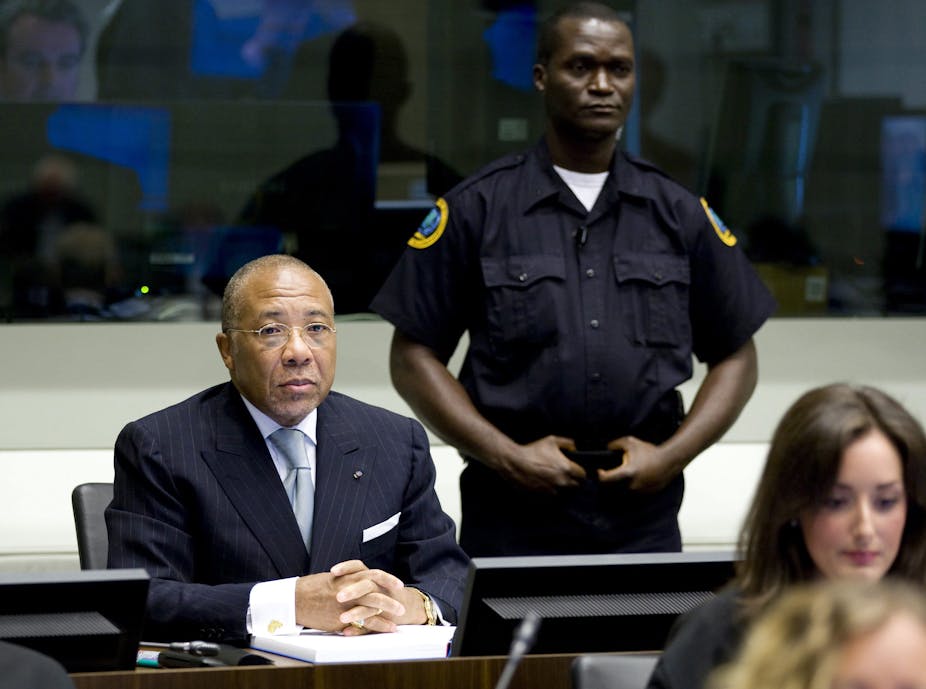The recent decision of the Special Court for Sierra Leone (Special Court) in the trial of former President of Liberia, Charles Taylor, is a landmark and historic verdict.
Why is the judgement an important one for gender-based jurisprudence?
It is the first time a former head of state has been convicted by an international criminal court for gender-based crimes. International gender crimes scholar, Dr Kelly Dawn Askin, lauded the verdict as a “major victory for gender justice worldwide”.
The Special Court’s judgement affirms the increased recognition of gender-based violence in international law.
Former head of state responsible for gender crimes
The Trial Chamber of the Special Court found Taylor guilty of aiding and abetting the Revolutionary United Front (RUF), Armed Forces Revolutionary Council (AFRC), AFRC/RUF junta and Liberian fighters in the commission of crimes during the Sierra Leone civil war between 1996 and 2002.
Taylor was indicted on direct and indirect forms of criminal responsibility. Direct forms of responsibility are described by the Statute of the Special Court, as planning, ordering, instigating, or aiding and abetting crimes. The indirect form is superior responsibility.
The prosecution also alleged that Taylor was part of a joint criminal enterprise. The Special Court judges rejected this submission. Conceptual issues with the prosecution’s framing of liability were evident during the trial, as Professor William Schabas highlights.

Taylor was charged with individual criminal responsibility for crimes against humanity, war crimes and serious violations of international humanitarian law.
The Statute of the Special Court’s definition of crimes against humanity includes rape, sexual slavery, forced pregnancy, sexual violence and forced prostitution. Rape, humiliating and degrading treatment, enforced prostitution, indecent assault, and acts of terrorism are also defined as war crimes.
The Special Court determined that women and girls in the Kono and Kailahun Districts, and the Freetown and Western Area, were raped and/or forced to be sex slaves by the rebel forces.
The Special Court also considered rape within the broader ambit of terrorism. It held that rebel forces terrorised civilians in the target districts. The rebels raped women and girls in public as part of their campaign of terror.
How was Taylor involved? He provided the rebels with vital operational, financial, military and technical support, and arms and ammunition - in exchange for “blood diamonds”.
Taylor was found guilty of aiding and abetting the rebels, and in this sense, criminally responsible in the commission of gender-based atrocities.
The judges determined that Taylor had requisite knowledge of the commission of gender crimes - obtained through daily security briefings, public reports, intergovernmental reports, and media coverage.
It was established, beyond reasonable doubt, that Taylor possessed “a clear intent to act in support” of the gender crimes committed.
Forms of criminal responsibility are crucial as they enable prosecutions against high-ranking civilian or military superiors. Such charges ensure that superiors who formulate or implement overarching strategies and policies, for instance, are not exculpated on the grounds that they did not physically perpetrate crimes.
Recognising gender-based violence
Gender-based jurisprudence is continually evolving and expanding. Much of the substantive progress has been achieved in the past few decades.
In the post-World War Two period, sexual violence was not prosecuted at the Nuremberg Trials. In the trials of Japanese war criminals before the International Military Tribunal for the Far East, rape was prosecuted under general prohibitions against attacks on “family honour”.
In the 1990s, the International Criminal Tribunal for the former Yugoslavia, and the International Criminal Tribunal for Rwanda, significantly contributed to the evolution of gender jurisprudence. Rape, as a crime against humanity, was expressly recognised in their statutes and decisions.
The 1998 judgement of Rwandan politician Jean Paul Akayesu was the first time an international criminal court held that rape was a crime against humanity, and that rape and sexual violence could constitute genocidal acts (accompanied with the requisite intent).
Taylor’s trial shows an increased awareness by the international community of gender-based violence during war, and the need to formulate appropriate gender strategies in prosecutions of those responsible.
Justice for women and girls in Sierra Leone
The Truth and Reconciliation Commission (TRC) for Sierra Leone was established in 2000. The TRC’s 2004 report recommended that the government compensate victims. The reparations process has been a difficult and slow one, hampered by inadequate resources.

While the TRC has focused on providing a forum for victims’ voices and directing reparations, the Special Court’s mandate is to “prosecute persons who bear the greatest responsibility for serious violations” committed in the civil war.
The symbolism of the Special Court’s retributive and punitive verdict should be emphasised - particularly with regard to victims of gender crimes.
Margot Wallström, the United Nations Secretary-General’s Special Representative on Sexual Violence in Conflict, stated that the Taylor verdict “signals that no leader – however powerful – is above the law; and that no woman or girl is below it.”
Victims of gender-based violence in war have been historically ignored, shunned and stigmatised.
This verdict is a monumental affirmation of the inherent rights of women and girls in Sierra Leone - and that these rights are inviolable, regardless of the rank or status of persons responsible.

